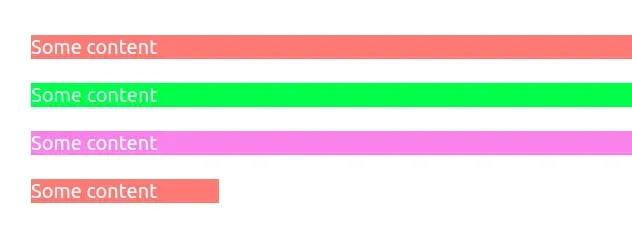在 React.js 中设置内联样式
Setting inline Styles in React.js
在 React 中设置内联样式:
- 将
style元素上的 prop 设置为一个对象。 - 设置特定的 CSS 属性和值来设置元素的样式。
- 例如,
<div style={{backgroundColor: 'salmon', color: 'white'}}>。
应用程序.js
const App = () => { const stylesObj = { backgroundColor: 'lime', color: 'white', }; const elementWidth = 150; return ( <div> {/* 👇️ set inline styles directly */} <div style={{backgroundColor: 'salmon', color: 'white'}}> Some content </div> <br /> {/* 👇️ set inline styles using an object variable */} <div style={stylesObj}>Some content</div> <br /> {/* 👇️ set inline styles conditionally using a ternary */} <div style={{ backgroundColor: 'hi'.length === 2 ? 'violet' : 'mediumblue', color: 'hi'.length === 2 ? 'white' : 'mediumpurple', }} > Some content </div> <br /> {/* 👇️ set inline styles interpolating a variable into a string */} <div style={{ width: `${elementWidth}px`, backgroundColor: 'salmon', color: 'white', }} > Some content </div> </div> ); }; export default App;

代码示例展示了在 React.js 中的元素上设置内联样式的多种方法。
第一个示例直接在元素上设置样式。
应用程序.js
<div style={{backgroundColor: 'salmon', color: 'white'}}> Some content </div>
请注意,在对象上设置时,像这样的多词属性background-color是驼峰式的。style
该style属性的值包含在 2 组花括号中。
内联样式中的第一组花括号标记表达式的开始,第二组花括号是包含样式和值的对象。
第二个示例将样式对象提取到一个变量中。
应用程序.js
const App = () => { const stylesObj = { backgroundColor: 'lime', color: 'white', }; return ( <div> {/* 👇️ set inline styles using an object variable */} <div style={stylesObj}>Some content</div> </div> ); }; export default App;
当您有多个共享相同样式的元素时,您可以使用这种方法。
您还可以使用
三元运算符在 React 中有条件地设置内联样式。
应用程序.js
<div style={{ backgroundColor: 'hi'.length === 2 ? 'violet' : 'mediumblue', color: 'hi'.length === 2 ? 'white' : 'mediumpurple', }} > Some content </div>
if/else三元运算符与语句非常相似。
问号之前的部分被评估,如果它返回真值,则运算符返回冒号之前的值,否则返回冒号之后的值。
示例中的三元运算符检查length字符串hi的 是否等于2,如果等于,则返回属性的字符串violet,
backgroundColor否则返回mediumblue。
您还可以在设置内联样式时使用字符串插入表达式或变量。
应用程序.js
const App = () => { const elementWidth = 150; return ( <div> {/* 👇️ set inline styles interpolating a variable into a string */} <div style={{ width: `${elementWidth}px`, backgroundColor: 'salmon', color: 'white', }} > Some content </div> </div> ); }; export default App;
在设置样式时,我们使用
模板文字
来连接字符串和变量。
元素的width属性设置为。div150px
请注意,字符串包含在反引号 “ 中,而不是单引号中。
美元符号和花括号语法允许我们使用被评估的占位符。
React 中一个常用的模式是提取具有预定义样式的包装器组件,以呈现其childrenprop。
应用程序.js
function BoldText({children}) { return <span style={{fontWeight: 'bold'}}>{children}</span>; } const App = () => { return ( <div> <p> Hello <BoldText>World</BoldText> </p> </div> ); }; export default App;

这是一个非常简单的示例,但是BoldText组件在元素上设置了一些样式并渲染了它的childrenprop。
这种方法通常用于定义具有通常重用样式的包装器组件。
在 React 中编写内联样式的另一种方法是将样式写入带有.css扩展名的文件中。
应用程序.css
.bg-salmon { background-color: salmon; } .text-white { color: white; } .font-lg { font-size: 2rem; padding: 10px 10px; }
下面是我们将如何导入和使用这些类。
应用程序.js
// 👇️ import css file import './App.css'; const App = () => { return ( <div> <p className="bg-salmon text-white font-lg">hello world</p> </div> ); }; export default App;

在 React 中导入全局 CSS 文件时,最佳做法是将 CSS 文件导入到您的
index.js文件中。该index.js文件是您的 React 应用程序的入口点,因此它始终会运行。
另一方面,如果您将 CSS 文件导入到组件中,则一旦您的组件卸载,CSS 样式可能会被删除。
